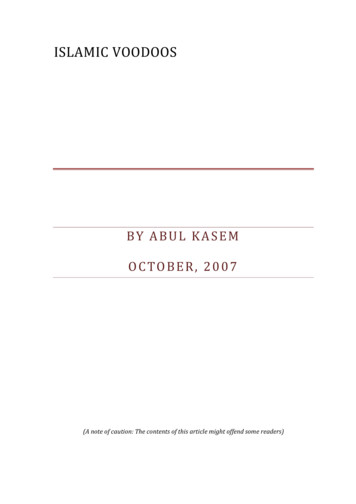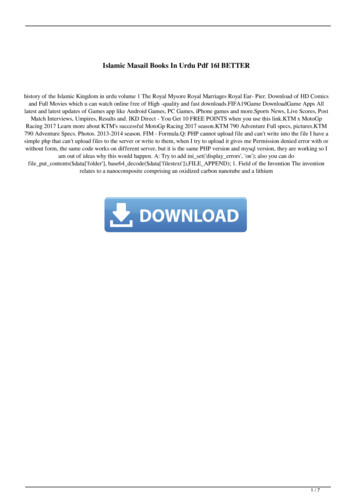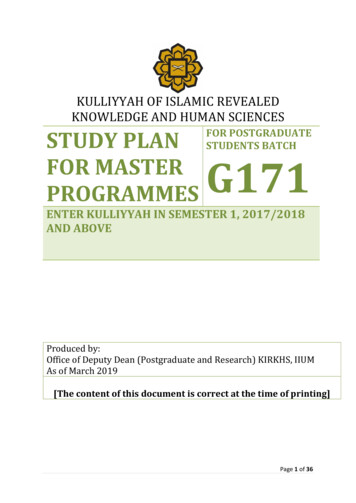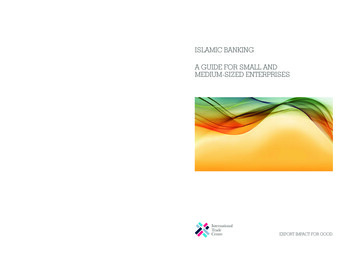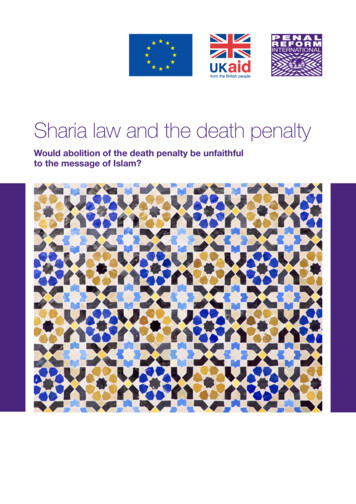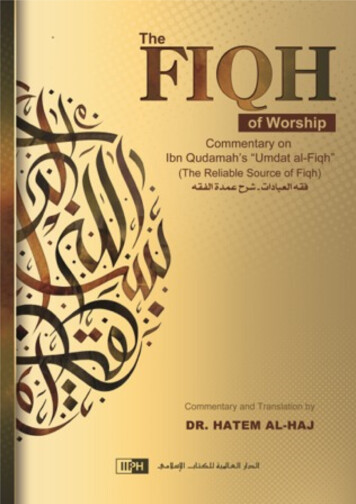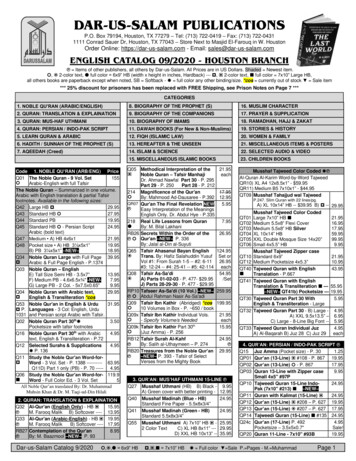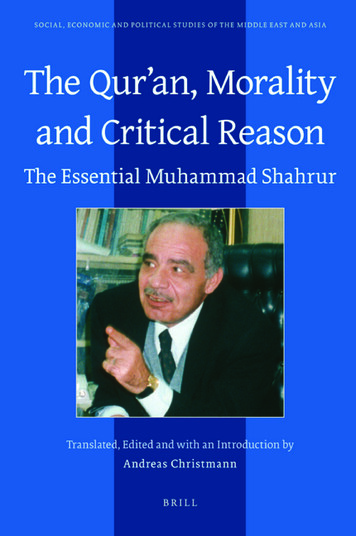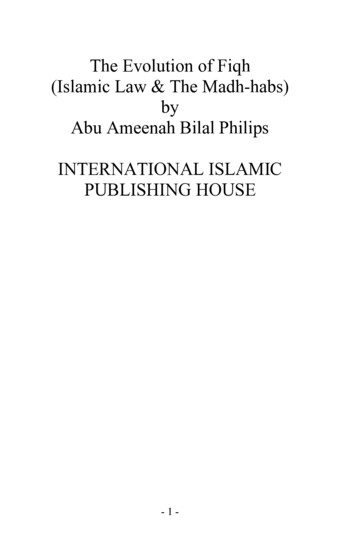
Transcription
The Evolution of Fiqh(Islamic Law & The Madh-habs)byAbu Ameenah Bilal PhilipsINTERNATIONAL ISLAMICPUBLISHING HOUSE-1-
Contents1.2.Preface to the Third EditinonPreface to the Second EditionTransliterationIntroductionThe First Stage: FoundationThe Method of LegislationGeneral Content of the Qur’aanThe Makkan Period (609-622 C.E.)The Madeenan Period (622-632 C.E.)Legal Content of the Qur’aanThe Basis of Legislation in the Qur’aan1.The Removal of Difficulty2.The Reduction of Religious Obligations3.The Realization of Public Welfare4.The Realization of Universal JusticeSources of Islamic LawSection SummaryThe Second Stage: EstablishmentProblem-Solving Proceduresof the Righteous CaliphsIndividual Sahaabah and IjtihaadAbsence of FactionalismCharacteristics of FiqhSection Summary3.The Third Stage: BuildingFactors Affecting FiqhCharacteristics of FiqhReasons for DifferencesCompilation of Fiqh-2-
4.Section SummaryThe Fourth Stage: FlowingThe Development of FiqhPeriod of the Great ImamsPeriod of the Minor ScholarsSources of Islamic LawSection Summary5.The Madh-habs: Schools of Islamic Legal ThoughtThe Hanafee Madh-habAwzaa‘ee Madh-habThe Maalikee Madh-habThe Zaydee Madh-habThe Laythee Madh-habThe Thawree Madh-habThe Shaafi‘ee Madh-habThe Hambalee Madh-habThe Dhaahiree Madh-habThe Jareeree Madh-habSection Summary6.Main Reasons for Conflicting Rulings1.Word Meanings2.Narrations of Hadeeths3.Admissibility of Certain Principles4.Methods of QiyaasSection Summary7.The Fifth Stage: ConsolidationFour Madh-habsCompilation of FiqhSection Summary-3-
8.The Six Stage: Stagnation and DeclineEmergence of TaqleedReasons of TaqleedCompilation of FiqhReformersSection Summary9.Imaams and TaqleedImaam Abu HaneefahImaam Maalik ibn AnasImaam Ahmad ibn HambalStudents of the ImaamsCommentSection Summary10.11.Differences Among The UmmahDifferences Among the SahaabahSection SummaryConclusionDynamic FiqhProposed StepsContradictory and Variational DifferencesGlossaryIndex of HadeethsBibliography-4-
PREFACE TO THE THIRD EDITIONA little over a year has passed since the second edition ofthis book was published, and, by God’s grace, copies are no longeravailable for distribution. However, the public demand for the bookhas progressively increased, especially since its disappearance fromthe bookstores. My impressions concerning the need throughout theMuslim world for the clarifications and recommendations containedin the text have proven true. Not merely because the book has beenrelative commercial success, but because of the very positiveintellectual response which I have received from those who has readit. In fact, in order to make the information contained in the textavailable to an even wider audience, some readers have alreadyundertaken a Tamil translation of the book, and an Urdu translationhas also been commissioned. Consequently, I felt obliged to reprintthe book, in order to meet the growing commercial demand for thebook.Due to technical problems faced in the first edition whichcaused the print on some of the pages to be faded, I decided to retypeset the whole text. This also gave me an opportunity to apply thetransliteration scheme more carefully throughout the text than in thefirst edition. I also changed the title of the book from Evolution ofthe Madh-habs to The Evolution of Fiqh (Islamic Law & The Madhhabs) in order to further clarify the subject matter of the book. Withthe exception of chapter one (The First Stage), which has beenalmost totally rewritten, only a few changes have beenmade withinthe text itself: corrections where necessary and improvements wherepossible. However, with regards to the footnotes, there have beenquite a few modifications. All the Hadeeths mentioned in the texthave been thoroughly referenced to existing English translations,with the help of brother Iftekhar Mackeen. As for thoseHadeethsmentioned in the book which are not found in Saheeh al-Bukhaareeof Saheeh Muslim, I have endeavored to have them all authenticatedin order to remove any doubts in the reader’s mind as to theirreliability and the conclusions based on them. Likewise, Hadeeths-5-
which were alluded to in the text have been quoted in the footnotesand or referenced. There have also been some cosmetic changes, likethe improved cover design and the reduction of the size of the book,all of which I hope will make this edition somewhat more attractivethan its predecessor.In closing, I ask Almighty Allah to bless this effort bymaking it reach those who may most benefit from it, and by adding itto my scale of good deeds on the day of Judgement.Abu Ameenah Bilal PhilipsRiyadh, August 23rd, 1990PREFACE TO THE SECOND EDITIONThe overall purpose of this book is to acquaint the readerwith the historical factors behind the formulation of Islamic law(Fiqh), in order that he or she may better understand how and whythe various schools of Islamic law (Madh-habs)1 came about. It ishoped that this understanding will in turn, provide a basis forovercoming the petty differences and divisions which occur whenpresent-day followers of different schools of people without definiteschools try to work together. Thus, another aim of this book is toprovide a theoretical framework for the reunification of the Madhhabs and an ideological basis for Islamic community work free fromthe divisive effects of Madh-hab factionalism.The pressing need for this book can easily be seen in thedilemma of convert Muslims. In the course of being educated in the1Madh-hab is derived from the verb Dhahaba which means to go. Madhhab literally means a way of going or simply a path. The position of anoutstanding scholar on a particular point was also referred to as his Madhhab (the path of his ideas or his opinion). Eventually, it was used to refer tothe sum total of a scholar’s opinions, whether legal or philosophical. Later itwas used to denote, not only the scholar’s opinion, but also that of hisstudents and followers.-6-
basic laws of Islaam, a convert Muslim is gradually presented with abody of laws based on one of the four canonical schools. At the sametime he may be informed that there are three other canonical schools,and that all four schools are divinely ordained and infallible. At firstthis presents no problem for the convert Muslim, since he merelyfollows the laws presented by his particular teacher, who of coursefollows one particular Madh-hab. When however, the new Muslimconvert establishes contact with other Muslims from various parts ofthe Islamic world, he invariably becomes aware of certaindifferences in some of the Islamic laws as taught by one of anotherof the Madh-habs. His teacher, a Muslim born into the faith, will nodoubt assure him that all four Madh-habs are correct in themselvesand that so long as he follows one of them he is on the right path.However, some of the differences from one school to another areperplexing for the new Muslim convert. For example, common sensetells him that one cannot be in a state of Wudoo2 while being out of itat the same time. But according to one Madh-hab, certain acts breakWudoo, while according to another Madh-hab those same acts donot3. How can a given act be both allowable (Halaal) and forbidden(Haraam) at the same time. This contradiction has also becomeapparent to thinking Muslims, young and old, who are concernedabout the prevailing stagnation and decline in the Muslim world andwho are advocating the revival of Islam in its original purity andunity.Faced with several unresolved contradictions, some Muslimshave chosen to reject the Madh-habs and their rulings, claiming thatthey will be guided only by the Qur’aan and the Sunnah4. Others takethe position that despite these contradictions the Madh-habs are2Usually translated as ablution it refers to a ritual state of purity stipulatedas a precondition for certain acts of worship.3See pages 76-7 of this book.4The way of life of the Prophet (sw.). His sayings, actions and silentapprovals which were of legislative value. As a body they represent thesecond most important source of Islamic law.-7-
divinely ordained and therefore one need only choole one of themand follow it without question. Both of these outcomes areundesirable. The latter perpetuates that sectarianism which split theranks of Muslims in the past and which continues to do so today. Theformer position of rejecting the Madh-habs in their entirety, andconsequently the Fiqh of earlier generations, leads inevitably toextremism and deviation when those who rely exclusively on theQur’aan and the Sunnah attempt to apply Sharee’ah law to newsituations which were not specifically ruled on in eitheir the Qur’aanor the Sunnah. Clearly, both of these outcomes are serious threats tothe solidarity and purity of Islam. As the prophet (sw.) stated, “Thebest generation is my generation and then those who follow them”5.If we accept the divinely inspired wisdom of the Prophet (sw.), itfollows that the farther we go from the prophet (sw.) generation, theless likely we are to be able it interpret correctly and apply the realintentions implied in the Qur’aan and the Sunnah. An equallyobvious deduction is the fact that the rulings of older scholars of noteare more likely to represent the true intentions deducible from theQur’aan and the Sunnah. These older rulings – the basis of Fiqh - aretherefore important links and guidelines which cannot wisely beignored in out study and continued application of Allaah’s laws. Itstands to reason that out knowledge and correct application of theselaws depend upon a sound knowledge of the evolution of Fiqh overthe ages. Similarly, a study of this development automaticallyembraces a study of the evolution of the Madh-habs and theirimportant contributions to Fiqh, as well as the reasons for apparentcontradictions in some of their rulings.Armed with this background knowledge, the thinkingMuslim, be he new convert of born into the faith, will be in aposition to understand the source of those perplexing contradictions5Narrated by ‘Imraan ibn Husain and collected by al-Bukhaaree(Muhammed Muhsin Khan, Sahih Al-Bukhari, (Arabic-English),(Madeenah: Islamic University, 2nd ed., 1976), vol.5,p.2, no.3.-8-
and to place them in their new proper perspective. Hopefully, he willthen join the ranks of those who would work actively for the reestablishment of unity (Tawheed), not only as the mainspring of ourbelief in Allah, but also in relation to the Madh-habs and to thepractical application of the laws which underlie and shape the way oflife known as Islam.The basic material for this book was taken from my clallnotes and research poapers for a graduate course on the history ofIslamic legislation (Taareekh at-Taashree‘) taught by Dr. ‘Assaal atthe University of Riyadh. The material was translated into English,further developed and utilized as teaching material for a grade twelveIslamic Education class which I taught at Manarat ar-Riyadh privateschool in 1880-81. This teaching text was published in the spring of1982 by As-Suq Bookstore, Brooklyn, New York, under the title,Lessons in Fiqh. The present work is a revised and expanded editionof Lessons in Fiqh.I would like to thank sister Jameelah Jones for patientlytyping and proofreading the manuscript, and my father, BradleyEarle Philips, for his suggestions and careful editing of the text.It is hoped that this book on the history of Fiqh will help thereader to place the Madh-habs in proper perspective and toappreciate the pressing need for their re-unification.In closing, I pray that Allaah, the Supreme, accept this minoreffort toward the clarification of His chosen religion, Islaam, as it isHis acceptance alone which ultimately counts.Was-Salaam ‘Alaykum,Abu Ameenah Bilal Philips25th Nov. 1983/21st Safar 1404-9-
�ghfqkArabicEnglishlmnhh/t6wyVOWELSShort VowelsaIuLong VowelseeooDipthongsawayIn order to provide the non-Arab with a more easily read set ofsymbols than those in current use, I have adopted a somewhatinnovative system of transliteration particularly with regard to longvowels. It should be noted, however, that a very similar system wasused by E.W. Lane in preparing his famous Arabic-English Lexicon,considered the most authoritative work in its field. Many otherscholarly texts, written to teach Arabic pronunciation, also use6This taa has been commonly transliterated as “t” in all cases. However,such a system is not accurate and does not represent Arabic pronunciation.- 10 -
similar systems. For example, Margaret K. Omar’s Saudi Arabic:Urbar Hijazi Dialect, (Washington, DC: Foreign Service Institute,1975), as well as the Foreign Language Institute’s Saudi-Arabic:Headstart (Monetery, CA: Defense Language Institute, 1980).No transliteration can express exactly the vocalic differencesbetween two languages nor can Roman characters give anythingmore than an approximate sound of the original Arabic words andphrases. There is also the difficulty of romanizing certaincombinations of Arabic words which are pronounced differentlyfrom the written characters. Included in this category is the prefix“al” (representint the article “the”). When it precedes wordsbeginning with letters known as al-Huroof ash-Shamseeyah (lit. solarletters), the sound of “l” is merged into the following letter; forexample, al Rahmaan is pronounced ar-Rahmaan. Whereas, in thecase of all other laetters, known as al-Qamareeyag (lit. lunar letters),the “al” is pronounced fully. I have followed the pronunciation forthe facility of the average reader by writing ar-Rahmaan instead ofal-Rahmaan and so on.Note:Shaddah () The Shaddah is represented in Roman letters bydoubled consonants. However, in actual pronunciation the lettersshould be merged and held briefly like the “n” sound produced bythe n/kn combination in the word unknown, or the “n” in unnerve,the “b” in grab-bag, the “t” in frieght-train, the “r’ in overruled, and“p” in lamp post, and the “d” in mid-day.I have made an exception with ( ), instead of iyy, I haveused eey as in islaameeyah because this more accurately conveys thesound.- 11 -
INTRODUCTIONFiqh and Sharee’ahFor a proper understanding of the historicaldevelopment of Islamic law, the terms Fiqh and Sharee’ahneed to be defined. Fiqh has been loosely translated intoEnglish as “Islamic law” and so has Sharee’ah, but these termsare not synonymous either in the Arabic language of to theMuslim scholar.Fiqh literally means, the true understanding of what isintended. An example of this usage can be found in the ProphetMuhammad’s statement: “To whomsoever Allaah wishes good,He gives the Fiqh (true understanding) of the Religion”7.Technically, however, Fiqh refers to the science of deducingIslamic laws from evidence found in the sources of Islamiclaw. By extension it also means the body of Islamic laws sodeduced.Sharee’ah, literally means, a waterhole where animalsgather daily to drink, or the straight path as in the Qur’anicverse.“Then we put you on a straight path(Sharee’ah) in you affairs, so follow it and donot follow the desires of those who have noknowledge.”8Islamically, however it refers to the sum total of Islamic lawswhich were revealed to the Prophet Muhammad (SW.), and7Reported by Mu‘aawiyah and collected by al-Bukhaaree (Sahih AlBukhari (Arabic-English), vol.4, pp. 223-4, no.346), Muslim, (AbdulHamid Siddiqi, Sahih Muslim (English Trans.), (Beirut: Dar al-Arabia,n.d.), vol.3, p. 1061, no.4720), at Tirmidhee and others.8Soorah al-Jaathiyah (45): 18.- 12 -
which are recorded in the Qur’aan as well as deducible fromthe Prophet’s divinely-guided lifestyle (called the Sunnah).9The distinctionFrom the previous two definitions, the following threedifferences may be deduced:1. Sharee’ah is the body of revealed laws found both inthe Qur’aan and in the Sunnah, while Fiqh is a body oflaws deduced from Sharee’ah to cover specificsituations not directly treated in Sharee’ah law.2. Sharee’ah is fixed and unchangeable, whereas Fiqhchanges according to the circumstances under which itis applied.3. The laws of Sharee’ah are, for the most part, general:they lay down basic principles. In contrast, the laws ofFiqh tend to be specific: they demonstrate how thebasic principles of Sharee’ah should be applied in givencircumstances.Note1. In this book on the evolution of Fiqh the term “IslamicLaw” will be used to mean the laws of Sharee’ah andthe laws of Fiqh combined. The terms Fiqh or Laws ofFiqh and Sharee’ah or Law of Sharee’ah will be usedwhere a distinction seems necessary.2. At the end of this book there is a glossary of Arabicterms and their plurals used in this book. In the text ofthis book the English plural is used except in caseswhere the Arabic plural is more widely known. Forexample, Muslims is used instead of Muslimoon andSoorahs instead of Suwar.9Muhammad Shalabee, all-Madkhal fee at-Ta’reef bil-fiqh al-Islaamee,(Beirut: Daar an-Nahdah al-Arabeeyah, 1969), p. 28.- 13 -
The Development of FiqhThe development of Fiqh falls traditionally into sixmajor stages named as follows: Foundation, Establishment,Building, Flowering, Consolidation, and Stagnation andDecline.These stages occur respectively in the following historicalperiods:a) Foundation: the era of the Prophet(SW.) (609-632 CE)10b) Establishment: the era of the RighteousCaliphs,fromthedeathoftheProphet (SW.) to the middle of the seventh century CE(632-661)c) Building: from the founding of theUmayyad dynasty (661 CE) until its decline in themiddle of the 8th century CE.d) Flowering: from the rise of the‘Abbaasid dynasty in the middle of the 8th century CEto the beginning of its decline around the middle of the10th century CE.e) Consolidation: the decline of the‘Abbaasid dynasty from about 960 CE to the murder ofthe last ‘Abbaasid Caliph at the hands of the Mongolsin the middle of the 13th century CE.f) Stagnation and Decline: from the sacking ofBaghdad in 1258 CE to the present.In this work the above mentioned stages in thedevelopment of Fiqh will be described with special reference tothe relevant social and political context of the respective10C.E. (i.e. Chirstian Era) is used instead of A.D. (Anno Domini, lit. in theyear of our Lord) because Muslims do not recognize Jesus the son of Maryas the Lord, but as a Prophet of God.- 14 -
periods. As the reader follows this development, he will begiven insight into the evolution of the Madh-habs (schools ofIslamic legal thought) as well as their contributions to Fiqh.Hopefully he will then be able to appreciate the fact that all theMadh-habs have contributed in different degrees to theDevelopment of Fiqh, and that no single Madh-hab canproperly be claimed to represent Islaam of Islamic law in itstotality. In other words, any one school of thought acting alonedoes not determine Fiqh. All Madh-habs have been importantinstruments for the clarification and application of theSharee’ah. Together, Fiqh and Sharee’ah should be unifyingforces that unite all Muslims regardless of place, time orcultural background. In fact, the only infallible Madh-hab thatdeserves to be followed without any questions asked is that ofthe Prophet Muhammad himself (SW.). Only hisinterpretations of Sharee’ah can be considered divinely guidedand meant to be followed until the last day of this world. Allother Madh-habs are the result of human effort, and thus aresubject to human error. Or as Imaan ash-Shaafi’ee, founder ofthe Shaafi’ee Madh-hab, so wisely put it, “There isn’t any of uswho hasn’t had a saying or action of Allaah’s messenger (SW.)elude him of slip his mind. So no matter what rulings I havemade or fundamental principles I have established, there willbe in them things contrary to the way of Allaah’s messenger(SW.). However, the correct ruling is according to what themessenger of Allah (SW.) said, and that is my true ruling.”111. The First Stage: FOUNDATIONThe first stage in the development of Fiqh covers the era of theProphet Muhammad ibn ‘Abdillaah’s apostleship (609-632 CE)11Collected by al-Haakim with a continuous chain of reliable narratours toash-Shaari’ee (Ibn ‘Asaakir, Taareekh Dimishq, vol.15, sec. 1, p. 3 and ibnQayyim, I‘laam al-Mooqi‘een, (Egypt: Al-Haajj ‘Abdus-Salaam Press,1968), vol. 2, p. 363).- 15 -
during which the only source of Islamic law was divinerevelation in the form of either the Qur’aan or the Sunnah [thesaying and actions of the Prophet (SW.)]. The Qur’aanrepresented the blueprint in his day-to-day life (i.e. the Sunnah)acted as a detailed explanation of the general principlesoutlined in the Qur’aan as well as a practical demonstration oftheir application.12The Method of LegislationSections of the Qur’aan were continuously revealed to theProphet Muhammad (s.w.) from the beginning of hisprohethood in the year 609 CE until shortly before his death(623 CE), a period of approximately twenty-three years. Thevarious sections of the Qur’aan were generally revealed tosolve the problems which confronted the Prophet (SW.) and hisfollowers in both Makkah and Madeenah. A number ofQur’anic verses are direct answers to questions raised byMuslims as well as non-Muslims during the era of prophethood. Many of these verses actually begin with the phrase“They ask you about.” For example,“They ask you about fighting in theforbidden months. Say, ‘Fighting in them is agrave offense, but blocking Allaah’s path anddenying Him is even graver in Allaah’ssight.’ “13“They ask you about wine and gambling.Say, ‘There is great evil in them as well asbenefit to man. But the evil is greater thanthe benefit.’”1412al-Madkhal, p. 50.Soorah al-Baqarah (2): 217.14Soorah al-Baqarah (2): 219.13- 16 -
“They ask you about menses. Say, ‘It isharm, so stay away from (sexual relationswith) women during their menses.’ ”15A number of other verses were revealed due to particularincidents, which took place during the era of the Prophet (s.w.).An example can be found in the case of Hilaal ibn Umayyahwho came before the Prophet (s.w.) and accused his wife ofadultery with another of the Prophet’s companions. The Prophet(s.w.) said, “Either you will receive the fixed punishment (ofeighty lashes) on your back.” Hilaal said, “Oh Messenger ofAllaah! If any of us saw a man on top of his wife, would he golooking for witnesses?” However, the Prophet (s.w.) repeatedhis demand for proof. Then angel Gabriel came and revealed tothe Prophet (s.w.) the verse:16“As for those who accuse their wives andhave no evidence but their own, their witnesscan be four declarations with oaths by Allaahthat they are truthful and a fifth invokingAllaah’s curse on themselves if they are lying.But the punishment will be averted from thewife if she bears witness four times with oathsby Allaah that he is lying, and a fifth oathinvoking Allaah’s curse on herself if he istelling the truth.”17The same was the case of Islamic legislation found inthe Sunnah, much of which was either the result of answers toquestions, or were pronouncements made at the time that15Soorah al-Baqarah (2): 222.16Collected by al-Bukhaaree (Sahih Al-Bukhari (Arabic-English), vol. 6,pp. 245-6, no. 271).17Soorah an-Noor (24): 6-9.- 17 -
incidents took place. For example, on one occasion, one of theProphet’s companions asked him, “Oh Messenger of Allaah!We sail the seas and if we make Wudoo (ablutions) with ourfresh water we will go thirsty. Can we make Wudoo with seawater?” He replied, “Its water is pure and its dead (seacreatures) are Halaal (permissible to eat).”18The reason for this method of legislation was toachieve gradation in the enactment of laws, as this approachwas more easily acceptable by Arabs who were used tocomplete freedom. It also made it easier for them to learn andunderstand the laws since the reasons and context of thelegislation would b e known to them. This method of graduallegislation was not limited to the laws as a whole, but it alsotook place during the enactment of a number of individuallaws. The legislation of Salaah (formal prayers) is a goodexample of gradation in the enactment of individual laws. Inthe early Makkah period, Salaah was initially twice per day,once in the morning and once at night.19 Shortly before themigration to Madeenah, five times daily Salaah was enjoinedon the believers. However, Salaah at that time consisted ofonly two units per prayers, with the exception of Maghrib(sunset) prayers, which were three units. After the earlyMuslims had become accustomed to regular prayer, thenumber of units were increased to four for residents, exceptfor Fajr (early morning) prayer and that of Maghrib.20General Content of the Qur’aan18Collected by at-Tirmidhee, an-Nasaa’ee, Ibn Maajah and Abu Daawood(Sunan Abu Dawud (English Trans.),p. 22, no. 38), an authenticated by alAlbaanee in Saheeh Sunan Abee Daawood, (Beirut: al-Maktab al-Islaamee,1st ed., 1988), vol.1, p.19, no. 76.19al-Madkhal, p. 74-8.20See Sahih Al-Bukhari (Arabic-English), vol.1,p.214, no. 346.- 18 -
In Makkah, Muslims were an oppressed minority,whereas after their migration to Madeenah they became theruling majority. Thus, the revelations of the Qur’aan duringthe two phases had unique characteristics which distinguishedthem from each other.The Makkan Period (609-622 CE)This period starts with the beginning of the prophethood in Makkah and ends with the Prophets Hijrah (migration)to the city of Madeenah. The revelations of this period weremainly concerned with building the ideological foundation ofIslaam, Eemaan (faith), in order to prepare the early band ofconverts for the difficult task of practically establishing thesocial order of Islaam. Consequently the following basictopics of the Makkan revelations all reflect one aspect. Oranother of principles designed to build faith in God.(i) Tawheed (Allaah’s Unity)Most of the people of Makkan believed in a SupremeBeing known by the name “Allaah” from the most ancientof times. However, they had added a host of gods whoshared some of Allaah’s powers or acted as intermediaries.Accordingly, Makkan revelations declared Allaah’s uniqueunity and pointed out that gods besides Allaah are nobenefit.(ii) Allaah’s ExistenceSome of the early verses presented logical argumentsproving the existence of God for the few Makkans whoactually denied it.(iii) The Next LifeSince there was no way for human beings to know aboutthe next life, the Makkan revelations vividly described itswonders, its mysteries and its horrors.- 19 -
(iv) The people of GodThe Makkan verses often mentioned historical examples ofearlier civilizations which were destroyed when theydenied their obligation to God, like the ‘Aad and theThamood, in order to warn those who rejected the messageof Islaam and to teach the believers about the greatness ofAllaah.(v) Salaah (Formal Prayer)Because of the critical relationship between Salaah andTawheed, Salaah was the only other pillar of Islaam to belegislated in Makkah, besides the declaration of faith(Tawheed).(vi)ChallengesIn order to prove to the pagan Makkans that the Qur’aanwas from God, some of the Makkan verses challenged theArabs to imitate the style of the Qur’aan.21The Madeenan Period (622-632 CE)The Hijrah marks the beginning of this period and thedeath of the Prophet (s.w.) in 632 CE marks the end. After theProphet’s migration to Madeenah and the spread of Islaamthere, he was appointed as the rular, and the Muslimcommunity became a fledgling state. Thus, revelation wasconcerned primarily with the organization of the MuslimState. And it was during this period that the majority of thesocial and economic laws of the Sharee’ah were revealed.Revelations during this period also strengthened thefoundations of Eemaan and Tawheed, which were establishedduring the Makkan period. However, most of the followingbasic topics of the Madeenan revelations concentrate on thelaws necessary for the development of an Islamic nation.(i) Laws21al-Madkhal, 51-5.- 20 -
It was during the Madeenan period that the last threepillars of Islaam were revealed, as well as the prohibitionof intoxicants, pork, gambling, and the punishments foradultery; murder and theft were fixed.(ii) JihaadDuring the Makkan period, Muslim were forbidden to takeup arms against the Makkans who were oppressing them,in order to avoid their decimation and to develop theirpatience. The right to fight against the enemy as well asthe rules of war was revealed in Madeenah after thenumbers of Muslims had dramatically increased.(iii) People of the BookIn Madeenah, Muslims came in contact with Jews for thefirst time and with Christians on a large scale. Thus, anumber of Madeenan verses tackled questions, which wereraised by the Jews in order to befuddle the Prophet (s.w.)and discredit Islaam. The verses also outlined lawsconcerning political alliances with Christians and Jews, aswell as laws permitting marriage with them.(iv) The Munaafiqs (Hypocrites)For the first time since the beginning of the final message,people began to enter the fold of Islaam without reallybelieving in it. Some entered Islaam to try to destroy itfrom within because Muslims were strong and they couldnot openly oppose them, while others entered and exitedshortly thereafter in order to shake the faith of thebelievers. Consequently, some Madeenan verses exposedtheir plots and warned against them, while others laid thefoundations for the laws concerning apostates.2222Mannaa’ al Qattaan, Mabaahith fee ‘Uloom al-Qur’aan, (Riyadh: Maktabal-Ma’aarif, 8th printing, 1981), pp. 63-4, and al-Madkhal, pp. 55-7.- 21 -
Qur’anic Fields of StudyThe body of information contained in the Qur’aan, as awhole, may be grouped under three headings with regards tothe fields of study to which they are related:First: Information related to Belief in God, His angels, Hisscriptures His prophets, and the affairs of the next life. Thesetopics are covered within the field of study known as theology(‘Ilm al-Kalaam of al-‘Aqeedah)Second: Information related to dee
Abu Ameenah Bilal Philips Riyadh, August 23rd, 1990 PREFACE TO THE SECOND EDITION The overall purpose of this book is to acquaint the reader with the historical factors behind the formulation of Islamic law (Fiqh), in order that he or she may better understand how and why the various schools of Islamic law (Madh-habs)1 came about. It is


